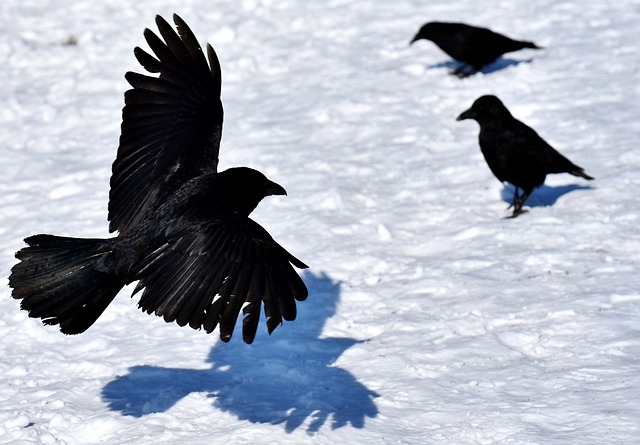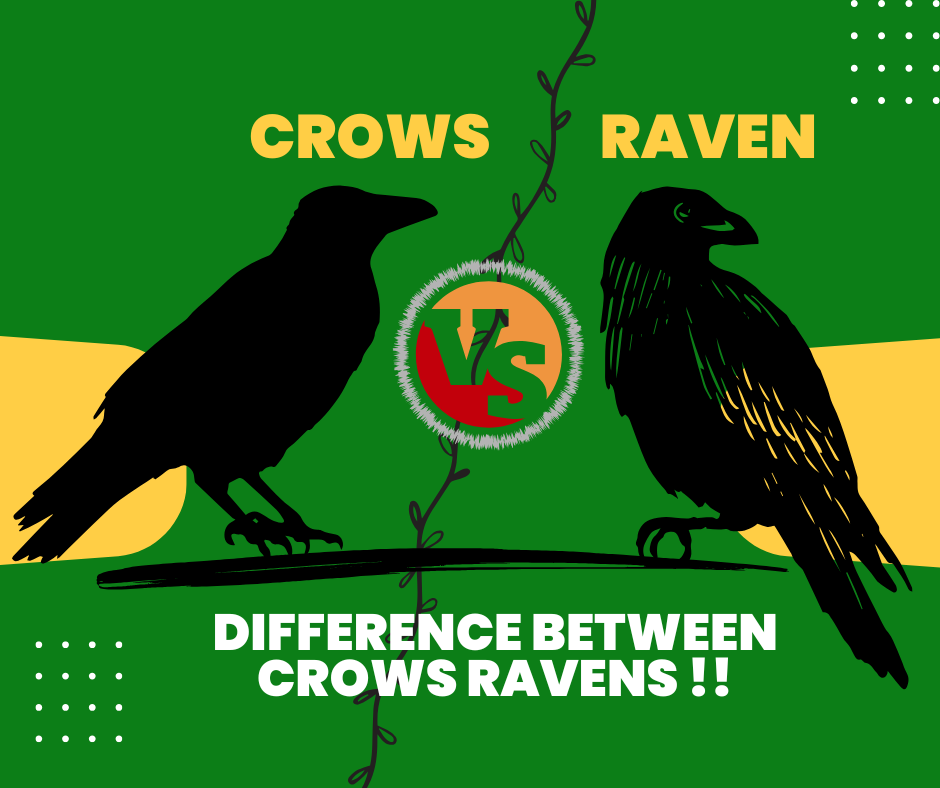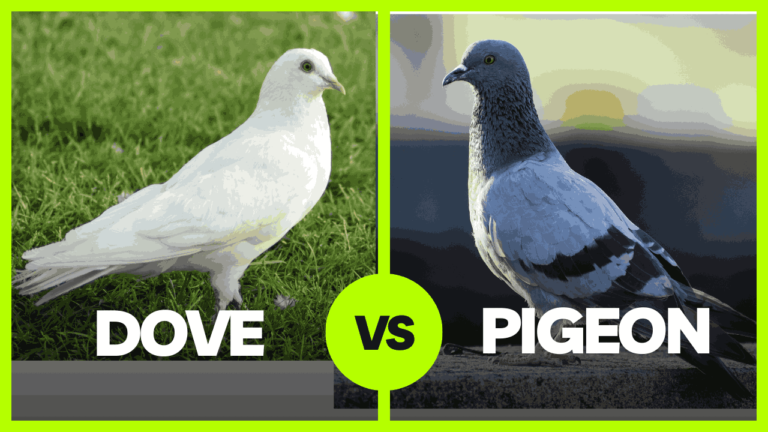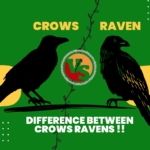Crows and ravens are probably the most intelligent and interesting birds in the world, which look similar but are different. Both belong to the Corvidae family, which includes magpies, jays, and nutcrackers. Although they resemble each other, there are a few differences in behavior and cultural roles between crows OR ravens. In this blog, we will learn everything you need to know about crows and ravens, including their physical differences, habitats, intelligence, myths, and much more.
What Are Crows and Ravens?

They are passerine birds more popularly known as perching birds or songbirds. They can be found over every region of the world, from forests to cities. These birds are characterized by their glossy black feathers, stout, sharp beaks, and incredible intelligence.
Scientific Classification
- Crows: The Corvus genus includes crow species such as the American crow (Corvus brachyrhynchos), carrion crow (Corvus corone), etc.
- Ravens: Similar to crows, ravens are also found in the same genus, including the common raven (Corvus corax).
Why Are They Often Confused?
At first glance, crows and ravens look almost alike. Their feathers are black and their voices sound almost identical. Nevertheless, once their distinguishing characteristics are known, identification becomes easier.
Physical Differences Between Crows and Ravens
| Physical Details | Crow | Raven |
|---|---|---|
| Size Type | Small | Large |
| length | 17-21 inches | 24-27 inches |
| wingspan | 32-40 inches | up to 46 inches |
| Beak | thinner, straighter beak, ideal for foraging. | larger and slightly curved, suited for tearing tough materials. |
| Tail Shape | Their tail feathers fan out evenly, creating a rounded shape when in flight. | Their tail is wedge-shaped, with central feathers longer than the outer ones. |
| Sound | “caw-caw” | “gronk-gronk.” |
Habitat and Distribution
Where Do Crows Live?
They are found on trees in human settlements, fields and parks. Crows are highly adaptable birds found in a wide variety of habitats, such as:
- Urban areas
- Forests
- Grasslands
- Coastal regions
Where Do Ravens Live?
Ravens prefer more remote areas compared to crows. They are commonly found in:
- Mountains
- Deserts
- Forests
- Tundras
Although ravens may sometimes be seen in urban settings, they generally avoid densely populated regions.
Intelligence of Crows and Ravens
Both ravens and crows are renowned for their intelligence. Studies have shown that they can solve complex problems, use tools, and understand cause-and-effect relationships. There are many stories to be read about the intelligence of crows.
Notable Examples of Intelligence
- Tool Use: Crows have been known to use sticks to extract insects from tree bark.
- Memory: Crows can remember human faces and differentiate between friendly and threatening individuals.
- Problem-Solving: Ravens can solve multi-step puzzles to access food.
- Communication: Both birds have complex systems of vocalizations and body language.
Cultural Significance
The crows and ravens have always been a great part of folklore, mythology, and literature around the world. Their mysterious black feathers and intelligent nature have given them the role of both good and bad omens.
Crows in Culture
- Crow are known to be the trickster or shapeshifters in Native American mythology.
- In Japanese culture, they are considered messengers of the gods.
Ravens in Culture
- In Norse mythology, the god Odin had two ravens called Huginn (thought) and Muninn (memory), who delivered information from around the world to him.
- Edgar Allan Poe’s famous poem “The Raven” is symbolic of grief and loss.
Diet and Feeding Habits

| Crows Eat | Ravens Eat |
|---|---|
| Fruits | Carrion (dead animals) |
| Seeds | Small mammals |
| Insects | Insects |
| Small animals | Berries |
| Human leftovers | Birds |
Social Behavior
Are Crows Social?
Crows are very social birds, sometimes forming groups called “crows”. Such large groups help in finding food, avoiding predators, and sharing information.
Are Ravens Social?
Ravens are less social than crows. They are typically seen alone or in pairs, especially during breeding season. They may form small groups when feeding on large carcasses.
How to Identify Crows and Ravens in the Wild
If you’re a birdwatching enthusiast and want to differentiate between crows and ravens, here are some tips:
- Size and Build: Ravens are visibly larger and bulkier.
- Tail Shape: Look at their tails during flight; crows have fan-shaped tails, while ravens have wedge-shaped tails.
- Call: Pay attention to their calls. Crows “caw,” while ravens “gronk.”
- Behavior: Crows are more social and seen in groups, whereas ravens are solitary or in pairs.
Fun Facts About Crows and Ravens
- Crows Remember Human Faces: It has been observed that crows can recall human faces and distinguish between amiable and threatening faces.
- Ravens are Mimics: Ravens are known to be very good mimics and can imitate human voices, animal voices, and even machine noises.
- Crows have “Funerals”: When a crow dies, the other crows gather around the dead bird. This might be to determine why the crow died.
- Ravens play Games: There are records of ravens sliding down snowy rooftops and playing with sticks.
- Crows use tools: They are one of the few bird species that are known to manufacture and use tools in the wild.
Conservation Status
Both ravens and crows are listed as species of “least concern” by the International Union for Conservation of Nature. However, in some areas, habitat loss, poisoning, and hunting are affecting their populations.
Common Myths and Misconceptions
Are Crows and Ravens Bad Omens?
In many Western cultures, Both are considered symbols of death and bad luck. However, in other cultures, they symbolize intelligence, wisdom, and protection.
Do Crows Steal Shiny Objects?
Partially true. This may be due to the curiosity of such behavior towards shiny objects which is not common in any population group.
How to Attract Crows or Ravens to Your Yard
If you’re fascinated by these birds and want to observe them up close, here are some tips:
- Provide Food: Place nuts, seeds, or small pieces of meat in a bird feeder.
- Offer Water: A bird bath or small water source can attract them.
- Create Perches: Install tall poles or branches for them to perch on.
- Maintain Quiet: Ensure the area is peaceful and free from potential threats.
FAQ
Crow and raven are not the same bird, although one is part of the Corvus genus. A raven is bigger with a wedge-shaped tail and croaking calls that are deeper, while a crow has a fan-shaped tail and makes higher-pitched “caw” sounds. Ravens inhabit solitary habitats while crows inhabit an urban and a suburban environment. They are both very smart birds, but there are some physical and behavioral differences that make the two different.
Possibly stronger and smarter but definitely not very intelligent both of them. Ravens excel at problem-solving, including tool use and mimicry, and they tend to outshine crows in more complicated feats. But crows are super social, good at collaborating and able to pick out faces and adjust to living in cities. Despite ravens being bigger and stronger, crows are equally impressive in terms of their adaptability and cleverness.
Yes, crows are far more aggressive than ravens, particularly when they’re defending their territory or nests. Crows are very social birds, and tend to mobilize as groups when mobbing predators or threats; they often display bold and confrontational behavior. Ravens are loners and will sidestep a fight when they can help it. Though crows may go for direct aggression, ravens rely on their size and intelligence to escape threats.
Crow and raven territorial squabbles — they bully the ravens over territory and resource issues, such as food and nest sites. Although smaller in size, crows are extremely social and live in flocks called murders, frequently to mob a larger predator or competitor, the raven. The crows work together to drive back the more solitary or pair-living raven species, allowing them to maintain the upper hand. The crow considers ravens to be a threat to themselves and their nests and this makes them defensive and aggressive.
No, crows and ravens — as members of the same genus Corvus — are not able to successfully interbreed because they are species and have differences in terms of genetics, behavior, and physical characteristics; in their size, mating rituals, and even habitat. While they do occasionally socialize with each other, those interactions tend to be competitive instead of reproductive.
No, crows do not become ravens. Crows and ravens are different species in the Corvus genus and never morph into each other. They appear similar, however, with their black feathers and high intelligence, though they vary in size, behavior, vocalizations, and preferences for habitat. The reason why most people believe crows can transform into ravens is probably based on myths or folklore, but scientifically, that is impossible.
Conclusion
Crows and ravens are interesting birds, rich in intelligence and adaptability with cultural significance. As much as they may look the same, they have different body features, habits, and habits that make them unique. This is an excellent experience for those who are nature lovers or want to know everything about birds.
So, the next time you spot a black-bird, take a closer look. Is it a crow or a raven? Either way, you are witnessing one of nature’s most intelligent and intriguing creatures.







